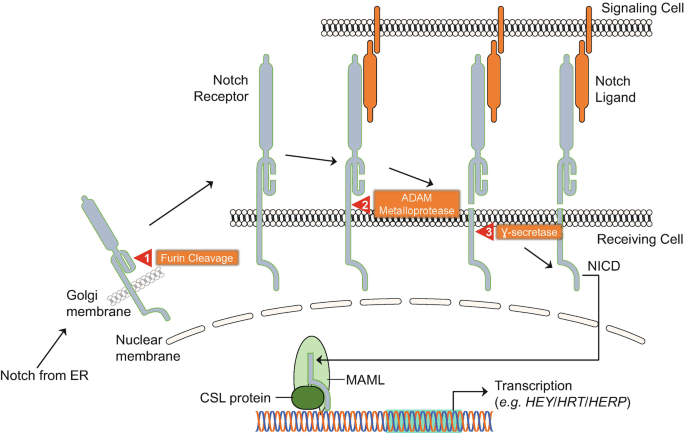
Activation of Notch Receptor by Cleavage
The Notch signaling pathway is crucial for various cellular processes, including cell differentiation, proliferation, and apoptosis. The activation of the Notch receptor involves a series of proteolytic cleavages.
- Ligand Binding: The process begins when a ligand from a neighboring cell binds to the Notch receptor on the target cell. This interaction typically occurs between Delta or Jagged ligands and the Notch receptor.
- Proteolytic Cleavage: Upon ligand binding, the Notch receptor undergoes a conformational change that exposes it to cleavage by an enzyme called ADAM (A Disintegrin and Metalloproteinase). This first cleavage occurs at the extracellular domain of the Notch receptor.
- Gamma-Secretase Cleavage: Following the initial cleavage, the remaining membrane-bound fragment of the Notch receptor is further cleaved by gamma-secretase, a multi-subunit protease complex. This second cleavage releases the intracellular domain of Notch (NICD) into the cytoplasm.
- Translocation to Nucleus: Once in the cytoplasm, NICD translocates to the nucleus where it interacts with transcriptional co-activators and DNA-binding proteins to regulate gene expression.
In summary, activation of the Notch receptor involves ligand binding followed by two critical cleavages—first by ADAM and then by gamma-secretase—resulting in transcriptional regulation within target cells.
Frizzled Receptors and Wnt Signaling
Frizzled receptors are a family of G protein-coupled receptors that play a pivotal role in Wnt signaling pathways, which are essential for embryonic development and tissue homeostasis.
- Wnt Protein Binding: The Wnt signaling pathway begins with Wnt proteins binding to Frizzled receptors on target cells. This interaction is often accompanied by another co-receptor called LRP5/6 (Low-Density Lipoprotein Receptor-Related Protein).
- Disruption of Destruction Complex: In absence of Wnt signaling, β-catenin is targeted for degradation by a destruction complex composed of Axin, APC (Adenomatous Polyposis Coli), and GSK3β (Glycogen Synthase Kinase 3 beta). When Wnt binds to Frizzled and LRP5/6, this complex is disrupted.
- Stabilization of β-Catenin: As a result of this disruption, β-catenin accumulates in the cytoplasm and eventually translocates into the nucleus.
- Gene Expression Regulation: In the nucleus, β-catenin acts as a co-activator for TCF/LEF transcription factors, leading to the expression of target genes involved in cell proliferation and differentiation.
Thus, Frizzled receptors mediate Wnt signaling through ligand binding that leads to stabilization and nuclear accumulation of β-catenin.
Hedgehog Signaling in Drosophila; NF-kB Dependent Signaling Pathway
Hedgehog (Hh) signaling is vital for developmental processes in Drosophila melanogaster and involves several key components:
- Hedgehog Ligand Release: The Hh protein is secreted from producing cells and binds to Patched (Ptc) receptors on receiving cells.
- Patched Inhibition Lifted: Normally, Ptc inhibits Smoothened (Smo), another transmembrane protein involved in signal transduction. When Hh binds to Ptc, this inhibition is lifted.
- Signal Propagation via Smo: Activated Smo triggers downstream signaling cascades that lead to changes in gene expression mediated by Cubitus interruptus (Ci), which can act as either an activator or repressor depending on its processing state.
- NF-kB Pathway Interaction: The NF-kB pathway can be activated through various stimuli including inflammatory signals or stress responses. In some contexts, Hedgehog signaling can interact with NF-kB pathways influencing cell survival and proliferation during development or disease states such as cancer.
Overall, Hedgehog signaling plays an integral role in developmental biology while also having implications for understanding certain diseases through its interactions with other pathways like NF-kB.
Cleavage of Signaling Proteins by Matrix Metalloproteinases
Matrix metalloproteinases (MMPs) are enzymes that degrade various components of the extracellular matrix but also play roles in cleaving signaling proteins:
- MMP Activation: MMPs are synthesized as inactive proenzymes that require activation through proteolytic cleavage or other mechanisms before they can function.
- Cleavage Targets: MMPs can cleave growth factors such as fibroblast growth factor (FGF) or transforming growth factor-beta (TGF-β), releasing active forms that can engage their respective receptors leading to downstream signaling events related to cell migration, proliferation, or differentiation.
- Role in Disease: Dysregulation of MMP activity has been implicated in various pathological conditions including cancer metastasis where MMPs facilitate tumor invasion through ECM degradation while also modulating local growth factor availability.
Thus, MMPs serve dual roles not only in matrix remodeling but also as modulators of cellular signaling through their ability to cleave specific proteins involved in these pathways.
Cleavage of Amyloid Precursor Protein and Alzheimer’s Disease
The amyloid precursor protein (APP) is central to Alzheimer’s disease pathology due to its processing leading to amyloid-beta peptide formation:
- APP Processing Pathways: APP can be processed via two main pathways—non-amyloidogenic involving α-secretase which prevents amyloid-beta formation or amyloidogenic involving β-secretase followed by γ-secretase cleavage resulting in amyloid-beta production.
- Amyloid-Beta Accumulation: Accumulation of amyloid-beta peptides leads to plaque formation which is one hallmark feature observed in Alzheimer’s disease brains contributing to neurodegeneration through mechanisms such as inflammation or synaptic dysfunction.
- Therapeutic Targets: Understanding APP processing has led researchers to explore therapeutic strategies aimed at inhibiting β-secretase or γ-secretase activities as potential treatments for Alzheimer’s disease aiming at reducing amyloid plaque burden.
In conclusion, cleavage events involving APP are critically linked with Alzheimer’s disease progression highlighting their importance as targets for intervention strategies aimed at mitigating cognitive decline associated with this condition.







